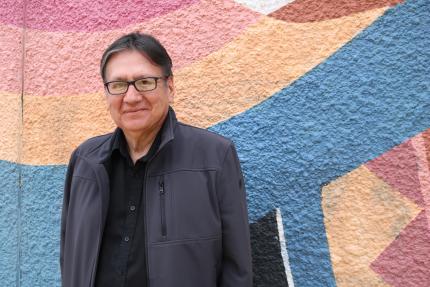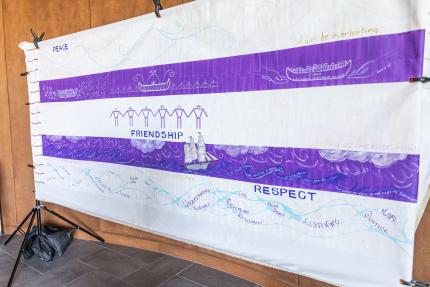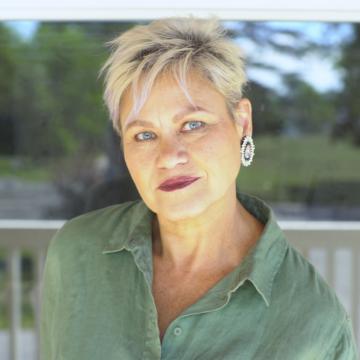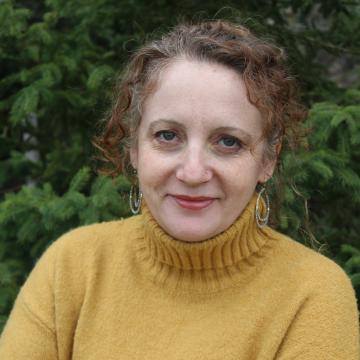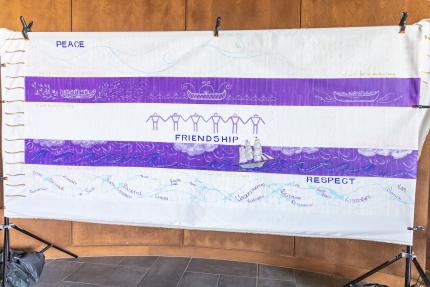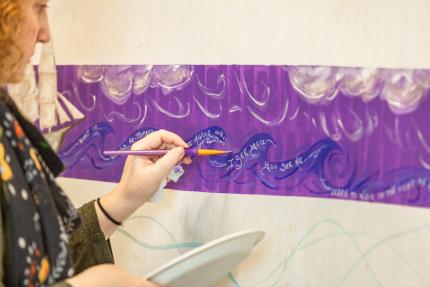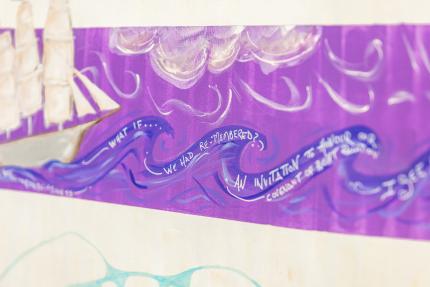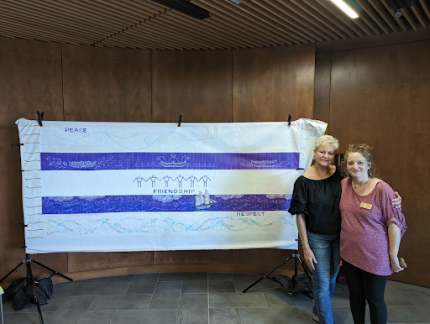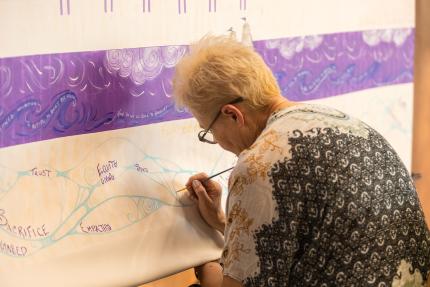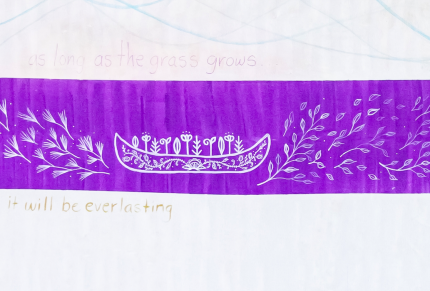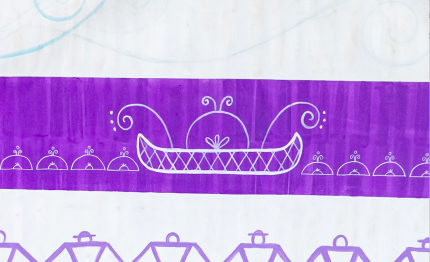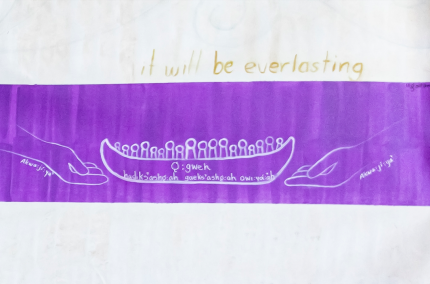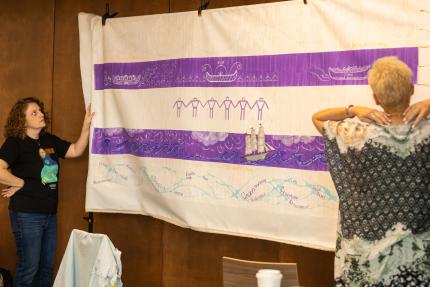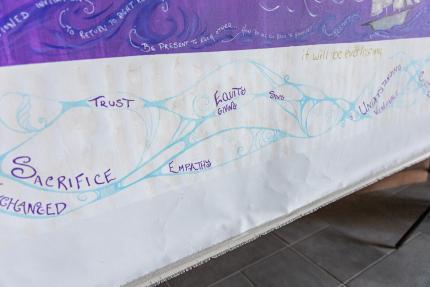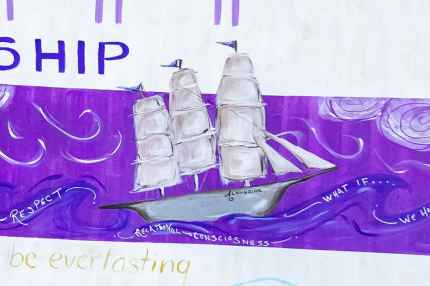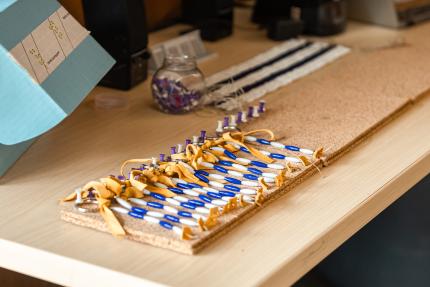
Sign up for our regular email for updates on ministry in Canada.
Over 150 people gathered May 25-28, 2023 in Ottawa, Ontario on the campus of Algonquin College for the Canadian National Gathering. Representatives from every classis across Canada participated. A key area of emphasis was on Hearts Exchanged and the work of reconciliation with Indigenous brothers and sisters. During the course of this event this work of art was created.
Jacobs chose to incorporate art as a means of expression for the Canadian National Gathering. Here he discusses his perspective on this decision:
Having listeners who could reflect back to the Canadian National Gathering what they were hearing, seeing, feeling, etc. in a visual way would give us an embodied perspective on what the Spirit was saying to the Canadian churches of the Christian Reformed Church in North America. Visual art speaks from a different place than words. The Two Row Wampum covenant belt in visual symbols articulated the original vision of a respectful relationship between very different nations. The white belt represented the common river of life where the Dutch ship of state and the Haudenosaunee canoe of state traveled into the future together. Peace, strength, and right relations were represented in the two rows of beads separating and connecting the two vessels. Neither nation was to interfere with the other’s vessel but could call upon each other to help in times of struggle.
Lorrie, as Haudenosaunee, and Becky, as a Canadian settler, embodied this mutuality in artistic expression. Through their senses they absorbed the experiences of the Canadian National Gathering in a Two Row Wampum kind of way. They cooperated and communicated together in mutuality but then gave of their own aesthetic skills in an artistic expression of the original intent of our ancestors. In our planning we imagined a possible outcome but what we received in the final product was way beyond our naive expectations. This art piece invites you into a long reflective journey, with each image speaking in ways that time will unfold. I think our ancestors are happy.
Gallant is Haudenosaunee, Cayuga Nation, Six Nations of the Grand River Territory Ontario. Gallant is a wife, mother, and grandmother. She’s a writer and illustrator, with several books published by Indigenous Education Press. She is a storyteller, singer, visual artist, educator, and an Associate Expressive Arts Practitioner. Gallant sits on various Boards as Indigenous Advisory and works for several organizations facilitating and teaching about the Impacts of Colonization and the Indian Residential School. All of her writing, teaching and art is inspired by her family, her Indigenous family history,and the history, and current issues of Indigenous Peoples.
Jones-Teeple lives on the Treaty Lands and Territory of the Mississaugas of the Credit. Jones-Teeple is a mom, a daughter and wife. She attended The Toronto Metropolitan University for Applied Arts and then went on to attend the Toronto Art Therapy Institute to become an art therapist. She recently graduated from Wilfred Laurier with a Masters in Theology, Spiritual Care and Psychotherapy and a Certificate in Disability, Inclusive Ministry and Christian Faith. She has spent her career working in museums and galleries, owning her own art therapy business and most recently, working for the Christian Reformed Church in North America.
The Guswenta or Two Row Wampum symbolizes a relationship. The two purple rows represent parallel paths of two vessels. These vessels were to be put into the river at the same time, to float down the river alongside each other, to travel side by side, never outpacing the other, nor trying to steer each others vessel and the paths should remain separate and parallel forever, that is as long as the grass grows, the rivers flow, the sun shines, it will be everlasting, and they shall always renew their treaties.
Originally made between the Mohawk and the Dutch in 1613 it was to be a symbol of how we were to co-exist. It was an agreement made as equals in a relationship representing multiculturalism – how we allow for multiple cultures to share space and enjoy separate traditional values, governances, spirituality, and ways of life, while exercising law and commerce and all those things that guide the relationship of Nations. This is an understanding that we need to continue to strive for.
The white lines represent how we navigate this relationship which are, peace, friendship and mutual respect. The river symbolizes how we are united as equals, like brothers. Our journey on the river of life, side by side should be harmonious, parallel but distinct in our ways.
If we were to think of having a vessel today, we should think of what we would put in that vessel. What would be important to keep, preserve, make sure it lasts generations beyond us. I have no right to represent what is in your vessel, or take what is in your vessel, but because I value you, I see you, I hear you, I respect you and I want to honour this treaty, what is important to you is now important to me. If we were to tell each other what we have in our vessels we may very well discover that some things we care about are very similar – language, culture, traditions, beliefs, home, family, environment. We need to share what these things are so that we become aware of what is important to each other, not so we can take it and use it for ourselves but so we can make space for us each to celebrate our unique and beautiful ways of life.
The Two Row is a foundational principle of a relationship of non-domination, balance, and harmony. It should continue to be an example of peace, friendship and respect that can exist within any relationship between people, Nations, and even the environment.
This art piece was created in harmony with Becky Jones who is a settler and of Swedish, Irish, and Welsh descent. The two of us symbolized in action what this Wampum literally means.
Haudenosaunee people uphold this treaty agreement today. As originally encouraged, that from time to time we will need to polish the silver to make it shine again, (covenant chain/friendship belt) so we should revisit this treaty from time to time to remind ourselves of our original agreements to live in peace, friendship and respect.
The symbols within the purple line of First Nations people represented in three vessels are the things that are important to us. These are the things we need restored so that we may renew our original relationship:
In the(Cayuga) Gayogo̱hó꞉nǫʼ language:
hadsá:’ashǫ:ah - male children
gaeks’ashǫ:ah - female children
This art piece will be a reminder that it is all our responsibility to continually renew this relationship with each other. It is a multicultural agreement, that all people of Turtle Island should live in harmony with each other and with the environment, that we may enjoy our best lives together as human beings and generations beyond us will also enjoy all that the Creator has provided. As long as the grass grows, as long as the rivers flow, as long as the sun shines, it will be everlasting.
I have heard Adrian share the meaning of the two row wampum in gatherings prior to the CNG. In other settings he was educating a room of settlers about the agreement made many years ago. However, this time, he was amongst his peers, other Indigenous people who knew about the treaty and had lived through the devastating effects of it being ignored. As he spoke, he grew very impassioned, calling all of us who had settled on Turtle Island and ignored the promises to task. He spoke of the original hope of traveling together - one group in their canoe, another in their ship and how that hope had been dashed and how brutal the outcomes were.
Following his conversation, I asked a few people to reflect on his words and share their thoughts on how we can move forward together and feelings surrounding this conversation. These words are in the waves of the sea. It is not a calm moment on the water at all. The waves are rolling forward with great resolve. This echoes the feelings of being in the space after Adrian had finished his speech. The energy was palpable in the room that we had been called to action.
The ship sailing forward in the water bears the name Alongside. Our call to action was to come alongside our brothers and sisters with respect. And yet, notice how the ship is taking up space, pushing the boundaries of the row. Are we listening well? Are we following our Indigenous friend’s guidance or are we insisting on leading still? There seems to be that constant push pull between desire and reality of how we continue to show up in the world. We have a ways to go in learning how to walk alongside.
These keychains were created by participants at the Canadian National Gathering as a single strand of white and purple beads representing the Two Row Wampum and two silver beads to represent the Silver Covenant Chain. As each keychain was assembled during the Gathering participants would be reminded of what each bead represents in this important relationship. Three white beads symbolizing peace, friendship, and respect and the two purple beads symbolizing two distinct journeys one of Indigenous Peoples and the other of settlers. This strand would begin and end with a silver bead to remind us of the need to polish the silver from time to time to reaffirm peaceful relations, resolve disputes, and renew our friendships based on respect. As each keychain was created, they were placed side by side creating the Two Row Wampum as a collective. At the end of the National Gathering participants were invited to take a keychain to remind themselves of their individual responsibility in this relationship, that will always be, as long as the grass grows, the rivers flow and the sun shines.
